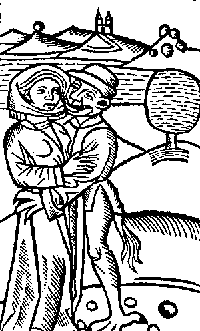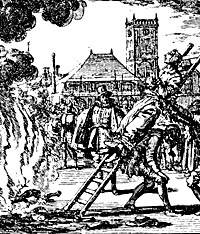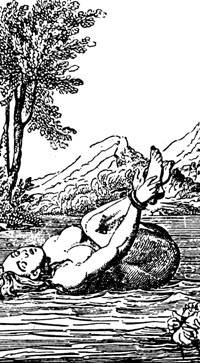
A witch is being visited by the
devil. ”The Devil is disguised as
a human being, but is easily
recognized by the tail
and the claws.
Witches and insanity (insane people).
The mentally ill may have played a significant role in the witch hunts, both as prosecutors and as alleged witches.
People suffering from paranoia and hallucinations may have acted as prosecutors. As with paranoid delusions in present times, these are often founded on our everyday conceptual frameworks, for example anxieties about radioactive rays, electrical installations and abduction by UFOs. In the past paranoid delusions were similarly based on the concepts of the time such as witchcraft, belief in elves, sorcery and kidnapping by the devil.
Witch processes
The Catholic Church had a tradition of burning heretics and people they accused of witchcraft (for example Jan Hus in 1415 and Joan of Arc in 1431). In 1484 the Pope issued a papal bull, which sounded the alarm, warning of the growth of witchcraft in Germany. Particularly in southern Germany thousands of witches were burnt.

The actual execution was in
Denmark the less painful
ladder method The "Witch" was
tied to a ladder
which then was toppled
into the prepared bonfires
The person accused of being a witch – often a demented old woman – had to confess her pact with the devil and by torture was forced to inform on her fellow witches (men and children were also burned on the stake). Frightened old women could be persuaded to confess involvement in Sabbaths for witches, and some even turned themselves in as being witches. Among these, there probably was a lot who were suffering from hallucinations.
Popular superstition
In addition to the zeal of the church, the belief in witches was rooted in popular old folkloric superstitions. Village societies saw ithemselves as surrounded by supernatural creatures - trolls, witches, giants, elves, etc. These beings could posses people (insanity) and destroy crops. If one bore a grudge against someone, the temptation to accuse this person of doing evil deeds was considerable.

The Water Test
When it had to be confirmed
whether a woman was awitch,
she was bound and
thrown into the water. If she
drowned she was
Innocent,
but if she floated, she was
guilty and was
burned
at the stake
Reformation and the belief in witches
By the time of the victory of Protestantism in northern Europe in the early 16th century, witch-hunting in earnest had been introduced in Denmark, though it never became as extensive as in southern Europe. Man now had to work out his own relationship with God. This was emphasized by a strong awareness of sin and a continuing firm belief in the power of the devil. Thus was the spiritual background, the devil had to be exorcised and destroyed by being burnt at the stake.
Witch persecutions in Denmark
The first known witch burnings took place in the year 1540. The last legal witch burning took place in 1693 and the last legal witch prosecution took place in Thisted in 1696-98. Here, the accused persons were acquitted, while the "possessed" who had pointed out the witches were prosecuted as fraudsters. Superstition of witches did however continue amongst the common folk. In The Age of Enlightenment in 1700 witches were still persecuted outside the law.
Murder and maltreatment of the Witches
The last extra-judicial witch murder in Denmark took place in 1800. The last unlawful mistreatment of a witch took place in 1897, and the last accusation of witchcraft was made in 1934



